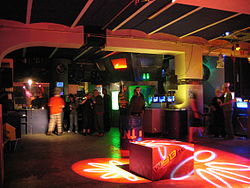This article needs additional citations for verification .(April 2009) |
 | |
 | |
| Formation | August 12, 1995 |
|---|---|
| Headquarters | Berlin |

c-base e.V. is a non-profit association located in Berlin, Germany. Its purpose is to increase knowledge and skills pertaining to computer software, hardware and data networks. The association is engaged in numerous related activities. For example, the society has had stands at large festivals, such as Children's Day, where they introduce young people to topics like robotics and computer-aided design.
Contents
The association's headquarters, c-base station, is also used by other initiatives and groups in and around Berlin as an event location or as function rooms, for example the wireless community network freifunk.net, the Chaos Computer Club and the Berlin Wikipedia group. Any group that identifies themselves with the purpose of the c-base are also welcome to use the premises for meetings and events.

